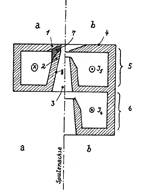Electron microscopy
(German original "Elektronenmikroskopie" by Dr. E. Kerschbaumer, published in DPMA-Erfinderaktivitäten 1986)
On occasion of the awarding of the 1986 Nobel Prize for Physics to Ernst Ruska, Gerd Binnig and Heinrich Rohrer, this article presents the patents providing the basis for the electron microscope, developed by E. Ruska, and for the scanning tunnelling microscope, developed by G. Binnig and H. Rohrer.
In 1928, E. Ruska started experimental research to explore the imaging properties of magnetic focussing coils for electron beams. He proved that these coils allowed to obtain images of objects by means of electron beams, in analogy to the light-optical imaging by means of light-optical focussing lenses.
Together with M. Knoll, Ruska assembled the first electron microscope, using magnetic coils that had an iron coating and were referred to as magnetic electron lenses. However, this electron microscope did not reach the maximum magnification obtained with light microscopes and did not yet present the advantage of electron microscopes over light microscopes, which consists in the following: If sufficiently magnified, images produced by means of electron beams provide a much more detailed view of an object due to the much shorter wavelength of electron beams.
This was only achieved by incorporating magnetic pole shoe lenses, shown in Fig. 2, for which E. Ruska and B. v. Borries applied for a German patent in 1932. A single lens is reproduced in the left half a of Fig. 2, and a double lens 5, 6 in the right half b. Currents I5 and I6 pass through the coils having a highly permeable jacket that is cut by a gap 7, whose interior diameter 8 has a funnel-shaped opening to the object side, and forms a funnel-shaped boring for the electron beam coming from the object. Gap 7 is limited by the tapered jacket parts 1 and 2, forming pole shoes. E. Ruska was the first to build an electron microscope featuring these pole shoe lenses that exceeded the maximum possible magnification of light microscopes and provided a much more detailed view of an object than formerly possible.
The classical Ruska-type electron microscope was further improved later, and new types of microscopes were designed, among them the scanning tunnelling microscope by G. Binnig and H. Rohrer, which marked a provisional end point.
Fig. 1 provides a schematic illustration of this scanning tunnelling microscope, for which a European patent application was filed in 1980, claiming the priority of a 1979 Swiss patent application.
A very fine tip 5 is suspended above an observed sample 4 and can be moved in relation to the latter in the three dimensions x, y, z by means of the piezoelectric transducers 6, 7, 8. Tip 5, sample 4 and transducers 6, 7, 8 are located in an ultra-high vacuum chamber 1, evacuated by means of the vacuum pump 2 and cooled down to sufficiently low temperatures by means of the cryogenic source 3. Tip 5 and sample 4 are moved relatively to each other in lateral direction in a raster-like pattern (x, y coordinates). The vertical distance (z coordinate) of tip 5 and sample 4 is kept so small (1 to 10 nanometers) that a tunnelling current will flow between tip 5 and sample 4 when an appropriate voltage is applied. If the vertical distance is modified by means of the measuring equipment 9 and the control equipment 10 in such a way that the tunnelling current is maintained at a constant level during the movement in lateral direction, tip 5 scans the surface of sample 4 at a constant vertical distance during the movement in lateral direction. The strongly magnified image of the surface of sample 4 can be reproduced on the plotter 12 or the screen 13, via the analysing device 11. It is also possible to investigate the chemical composition and the electronic structure of the sample.
The scanning tunnelling microscope allows for the first time to make details in atomic dimensions visible in the vertical direction to the sample surface.
Copyright © Deutsches Patent- und Markenamt 2004


